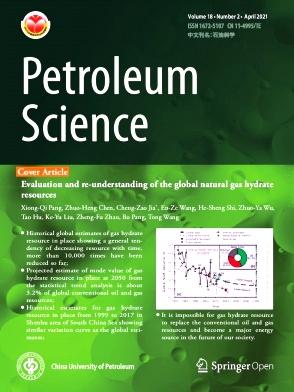中国西北部柴达木盆地东部瓯南断陷晚古生代以来热演化的重建:来自玻璃光泽反射率数据和(U-Th)/He热年代学的新制约因素
IF 6
1区 工程技术
Q2 ENERGY & FUELS
引用次数: 0
摘要
重建东柴达木盆地的热演化对于深入了解其岩石圈地球动力学以及更准确地评估和预测碳氢化合物具有重要意义。本文介绍了一组新的磷灰石和锆石(U-Th)/He热年代学年龄。结合336个玻璃光泽反射率(Ro)数据,利用反演模型重建了东柴达木盆地瓦南山渣的热历史。来自乌南岩渣的三个碎片样本显示,磷灰石(U-Th)/He 年龄主要集中在 17.0 Ma 至 76.5 Ma 之间,锆石(U-Th)/He 年龄在 200 Ma 至 289.3 Ma 之间。时间-温度模型表明,从石炭纪到二叠纪晚期,瓯南沙格经历了快速的沉降和加热,而从二叠纪末到三叠纪则经历了掘起/冷却事件。这种热演化过程分别受到了长岩的广泛侵入、柴达木弧下天体层上涌和南昆仑洋岩石圈板块回滚所引起的碰撞和造山运动的影响。此外,我们的模型还描绘了自古近纪以来的主要隆升/冷却阶段,以及中新世由于青藏高原的加剧增长和当地沉积负载而导致的再热事件,随后是最初的印度-欧亚大陆碰撞。此外,柴达木盆地东部在古生代晚期经历了持续加热,在二叠纪晚期达到最大古温度和地热梯度,分别为∼230 °C和∼43-44 °C/km。这项研究表明,瓯南沙格地区石炭系上统凯鲁克(C2k)地层最上层的源岩在二叠纪晚期达到了产气阶段。本文章由计算机程序翻译,如有差异,请以英文原文为准。
Reconstruction of the thermal evolution since the late paleozoic in the Ounan Sag, Eastern Qaidam Basin, NW China: New constraints from vitrinite reflectance data and (U–Th)/He thermochronology
Reconstructing the thermal evolution of the eastern Qaidam Basin is important for gaining a deeper understanding of its lithospheric geodynamics and for more accurate hydrocarbon evaluation and prediction. This article presents a set of new apatite and zircon (U–Th)/He thermochronological ages. Combined with 336 vitrinite reflectance (Ro) data, the thermal history of the Ouanan Sag in the eastern Qaidam Basin has been reconstructed using inversion models. Three detrital samples from the Ounan Sag shows that the apatite (U–Th)/He ages are primarily concentrated in the range of 17.0 Ma to 76.5 Ma and that the zircon (U–Th)/He ages range from 200 Ma to 289.3 Ma. The time-temperature models demonstrate that the Ounan Sag experienced rapid subsidence and heating from the Carboniferous to late Permian, and exhumation/cooling events from the end of Permian to the Triassic. This thermal evolution was influenced by the widespread intrusion of plutons, and the collision and orogenesis caused by asthenosphere upwelling below the Qaidam arc, and slab rollback of the Southern Kunlun oceanic lithosphere, respectively. Additionally, our models depict the main exhumation/cooling stages since the Paleogene and a reheating event in the Miocene as a result of the intensifying growth of the Qinghai–Tibet Plateau and local sedimentary loading, followed by the initial India–Eurasia collision. Furthermore, the eastern Qaidam Basin experienced consistent heating during the late Paleozoic, reaching the maximum paleotemperature and geothermal gradient in the late Permian, with values of ∼230 °C and ∼43–44 °C/km, respectively. This study suggests that the source rocks in the most upper member of upper Carboniferous Keluke (C2k) Formations in the Ounan Sag reached the gas generation stage in the late Permian.
求助全文
通过发布文献求助,成功后即可免费获取论文全文。
去求助
来源期刊

Petroleum Science
地学-地球化学与地球物理
CiteScore
7.70
自引率
16.10%
发文量
311
审稿时长
63 days
期刊介绍:
Petroleum Science is the only English journal in China on petroleum science and technology that is intended for professionals engaged in petroleum science research and technical applications all over the world, as well as the managerial personnel of oil companies. It covers petroleum geology, petroleum geophysics, petroleum engineering, petrochemistry & chemical engineering, petroleum mechanics, and economic management. It aims to introduce the latest results in oil industry research in China, promote cooperation in petroleum science research between China and the rest of the world, and build a bridge for scientific communication between China and the world.
 求助内容:
求助内容: 应助结果提醒方式:
应助结果提醒方式:


